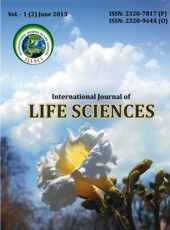Productivity and nutrient composition of four popular varieties of fodder Jowar
Keywords:
Sorghum, Cultivation, Cultivar, Productivity Nutrient CompositionAbstract
Plant cultivar of Sorghum viz. Harasona, Sweet Sorhum (local), Ruchira and Phule Yashoda were cultivated during 1999-2000, for the measurement of yield and to evaluate nutrient status. The overall results indicated that Harasona cultivar of Sorghum was more productive and could yield 64.60 t. green fodder per hectare in 83 days and also found suitable in nutrient composition.
Downloads
References
1. A.O.A.C. (1970) “Official and Tentative Methods of Analysis” IInd Edn. Association of Official Analaytical Chemists, Washingtaon D.C.
2. Bailey RL (1967) “Techniques in Protein Chemistry” IInd Edn. Elsevier Publishing Co. Amsterdam.
3. Bhagmal (1998) Indian J. Agri. Sci., 68(8): 439
4. Dakore HG (1985) “Studies on Protein Productivity and conservation of some forages of the Region” Ph. D. Thesis Dr. Babasaheb Ambedkar Marathwada University, Aurangabad.
5. Hazra CR (1996) Indian Farming 46 (1): 3
6. Lee R (1968) Laboratory handbook of Food analysis, XIV Edn. Leonard Hills books London.
7. Oser BL (1979) Hawks’ Physiological Chemistry, XIV Edn. Tata McGraw Hill Publishing Co. Ltd., New Delhi.
8. Shinde VK, Sudewad SM, Ambekar SS, Rodge BM and Shete DM (1994) J. Maha Agric. Univ., 19(1): 73
9. Vasanthi D, Kumarswami K and Subbiah S (1998) Forage Res. 24(3): 163.
Downloads
Published
How to Cite
Issue
Section
License
Copyright (c) 2013 Authors

This work is licensed under a Creative Commons Attribution-NonCommercial-NoDerivatives 4.0 International License.
Open Access This article is licensed under a Creative Commons Attribution 4.0 International License, which permits use, sharing, adaptation, distribution and reproduction in any medium or format, as long as you give appropriate credit to the original author(s) and the source, provide a link to the Creative Commons license, and indicate if changes were made. The images or other third party material in this article are included in the article’s Creative Commons license unless indicated otherwise in a credit line to the material. If the material is not included in the article’s Creative Commons license and your intended use is not permitted by statutory regulation or exceeds the permitted use, you will need to obtain permission directly from the copyright holder. To view a copy of this license, visit http://creativecommons.org/ licenses/by/4.0/











